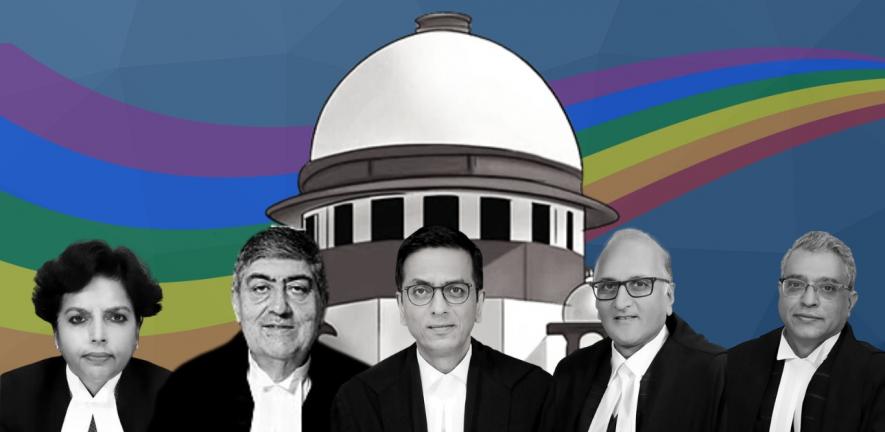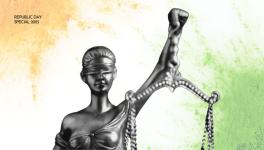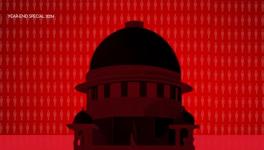As Supreme Court Begins Hearing a Batch of Petitions on Same-Sex Marriage Today, a Curtain-Raiser

The Union government has challenged the maintainability of the petitions seeking recognition of same-sex marriage in India, arguing that marriage is exclusively a heterogeneous institution and what has been represented before the court by the petitioners is a “mere urban elitist view” which does not reflect the views and voices of a far wider spectrum and expanse across the country.
| Case details: Supriyo@Supriya Chakraborty & Anr. versus Union of India & Ors.
Bench: CJI Dr D.Y. Chandrachud, and Justices S.K. Kaul, Ravindra Bhat, Hima Kohli and P.S. Narasimha Preliminary issues
Noteworthy developments:
|
AFTER having opposed the recognition of same-sex marriage at the Supreme Court via an affidavit on the grounds that marriage ‘necessarily and inevitably’ presupposes a union between two persons of the opposite sex, the Union government has now filed preliminary objections.
The government has termed same-sex marriage as an “urban elitist” phenomenon, saying, “The petitions … cannot be compared with the appropriate legislature which reflects the views and voices of the far wider spectrum … across the country.”
According to the preliminary objections, the Supreme Court should first decide whether it can legislate to create a “separate socio-legal institution of marriage” between persons not contemplated under existing law.
The Supreme Court Constitution Bench headed by Chief Justice of India (CJI) Dr D.Y. Chandrachud and comprising Justices S.K. Kaul, Ravindra Bhat, Hima Kohli and P.S. Narasimha is set to hear today a batch of petitions in Supriyo@Supriya Chakraborty versus Union of India & Ors. that seek recognition of the right to same-sex marriage, and challenge the constitutional validity of the Special Marriage Act, 1954, the Hindu Marriage Act, 1955, and the Foreign Marriage Act, 1969, which restrict marriage to only between a biological man and a biological woman.
These petitions would also deal with the issue of whether a right to marriage necessarily flows from the right to personal autonomy and decriminalisation of sexual orientation as expounded in judgments of the Supreme Court in National Legal Services Authority (NALSA) versus Union of India (2014) and Navtej Singh Johar versus Union of India (2018).
The court has agreed to hear the Union government on preliminary objections.
Recognition of marriage is essentially a legislative function
The Union government has opposed the recognition of same-sex marriage right on the ground that marriage is a “socio-legal institution” which is created and recognised by the competent legislature.
The Constitution specifically provides for Entry 5 in the Concurrent List of its Seventh Schedule on the constitutional function of legislating with respect to the institution of marriage.
Entry V reads: “Marriage and divorce; infants and minors; adoption; wills, intestacy and succession; joint family and partition; all matters in respect of which parties in judicial proceedings were immediately before the commencement of this Constitution subject to their personal law.”
The government has argued that the components of Entry 5 are “intrinsically interrelated” and any change in any one will necessarily have an “inevitable cascading effect” on the other.
Courts cannot, as per the government, “either create or recognise any institution called ‘marriage’ either by way of a judicial interpretation or striking down or reading down the existing legislative framework for the marriage…
“The Constitution has empowered only the competent legislature to decide a legislative policy as to which social relationship or ‘union’ should be recognised, which necessarily includes a decision based on the legislative policy…”
It has stated that it must be left to the legislature to determine whether the creation or recognition of same-sex marriage as a right would “diminish the special status enjoyed by the heterogenous institution of marriage across the country”.
Marriage is not a right except for heterosexual couples
The Union government has further stated that the adjudication of the Supreme Court in NALSA and Navtej Singh Johar was confined to the constitutional recognition of the autonomy of personal choice, freedom of sexual recognition and choice of sexual orientation as a matter of individual dignity.
All these rights are now fully protected and safeguarded by the competent legislature in the Transgender Persons (Protection of Rights) Act, 2019. However, the right to personal autonomy does not include a right to the recognition of same-sex marriage, that too by way of judicial adjudication.
The court had clarified in Navtej Singh Johar that the judgment does not deal with any sexual union in a form of marriage. Moreover, the creation or recognition of a new social institution cannot be claimed as a matter of right or choice, much less a fundamental right, according to the government.
It noted, “The statutory mechanism specifically, unequivocally and categorically recognises, respects, codifies and protects all the fundamental rights recognised by this … Court in the judgment of NALSA … and Navtej Singh … in case of Transgender Persons which are widely defined under the Act, except of course, marriage, which is not a right except in heterosexual couples.”
According to the Union government, it is the competent legislature that will have to take into account broader views and voices of all rural, semi-rural and urban populations, as well as views of religious denominations, keeping in mind personal laws and customs governing marriage together with its inevitable “cascading effect on several other statutes”.
Moreover, personal laws in India essentially represent a social concurrence by which certain norms have been crystallised into law. Any kind of judicial intervention to create this new institution of same-sex marriage “risks upsetting this balance”.
Any further creation of rights, recognition of relationship and giving legal sanctity to such relationship can only be done by a competent legislature and not by judicial adjudication, the Union government has contended.
It has relied on Ashwini Kumar Upadhyay versus Union of India & Ors. (2023), in which the Supreme Court last month dismissed petitions seeking “gender-neutral and religion-neutral laws” on the grounds that granting relief would necessitate a direction for the enactment of a law.
According to the Union government, this approach is attracted squarely in this present case as well.
No discrimination if only heterogenous marriage is recognised
As per the Union government, it is not discrimination to grant recognition to the heterogeneous institution of marriage alone to the exclusion of same-sex marriage. This is because conventional and universally accepted socio-legal relationships like marriage across all religions are deeply rooted in the Indian social context and are considered a sacrament in all branches of Hindu law.
This deeply rooted social context is also imbibed in the Special Marriage Act, which permits inter-religious and inter-caste marriage, and reflects a clear legislative policy of marriage between a biological man and a biological woman, the Union government has contended.
As per the government’s submissions, to give parity to same-sex marriage would amount to “conferring it with the same sanctity and legal status” and thereby comparing two non-comparable classes.
The government has relied on the recent United States Supreme Court decision in Dobbs versus Jackson Women’s Health Organization (2022) which held that abortion is not a constitutionally protected right in the United States and whether it is legal or not must be decided by state legislatures, to state that legislative bodies being the appropriate forum for decisions on such issues is nearly a universal approach.
The court observed that “fundamental rights must be objectively, deeply rooted in this nation’s history and tradition”.
A reference was also made to Justice Clarence Thomas’s concurring opinion in Dobbs, wherein he wrote that the United States Supreme Court should reconsider its decision in Obergefell versus Hodges (2015), which held that the fundamental right to marry is guaranteed to same-sex couples by the United States Constitution.
Privacy-based arguments not applicable to recognition of marriage
Arguments based on the right to privacy have “limited utility” towards the legal recognition of same-sex marriage as marriage is not and has never historically been confined to the private sphere, as per the Union government.
The regulation of marriage is an issue of “acceptance by society” and should only be debated by the competent legislature, which is the repository of democratic representation and reflects the will of the people. Similarly, inheritance and succession, among others, are all social norms governed by personal laws.
This rationale is the very basis for State recognition of marriage across jurisdictions, as marriage becomes the condition precedent for the State’s existence. It is natural that there would be a prevailing “legitimate State interest” adhering to the existing concept of marriage and preventing its dilution, except by the legislation.
Legislative intent was never to recognise homosexual marriage
The Union government has pointed out that the language used in the impugned laws makes it clear that the legislative intent was to recognise marriage as being the union of one man and one woman only.
The use of gender-specific language was a “conscious decision” of the Parliament and it shows that “gender-specific application of these laws is a part of the legislative policy”.
“The language employed in the provisions thereof e.g., ‘female‘, ‘woman‘, ‘husband‘ and ‘wife‘, is proof positive that the legislature in making these laws never intended that they should apply to any union other than heterosexual marriages. The terms used are specific, being capable of only one possible definition.”
The court should neither adopt a construction that would defeat such intent nor should it expand the definition of marriage for such classes who were never meant to be covered under it, the Union government has submitted to the Supreme Court.
Gursimran Kaur Bakshi is a staff writer at The Leaflet
Get the latest reports & analysis with people's perspective on Protests, movements & deep analytical videos, discussions of the current affairs in your Telegram app. Subscribe to NewsClick's Telegram channel & get Real-Time updates on stories, as they get published on our website.
























